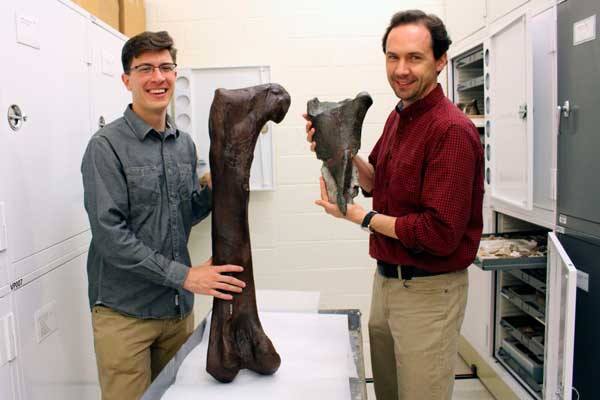The San Juan Islands are known for orcas, pristine beaches and charming storefronts. Now dinosaurs are putting the islands on the map.
As it turns out the San Juans very own Sucia Island is home to the first-ever discovery of a dinosaur fossil in Washington state.
Not just any dinosaur, mind you, but one from the family of carnivorous, ferocious creatures known as theropods, which includes Velociraptor, Tyrannosaurus rex and modern birds as well.
“The fossil record of the west coast is very spotty when compared to the rich record of the interior of North America,” said University of Washington biology grad student Brandon Peecook, who assisted the Seattle Burke Museum’s Dr. Christian Sidor, curator of vertebrate paleontology, in identifying the fossil.
“This specimen, though fragmentary, gives us insight into what the west coast was like 80 million years ago, plus it gets Washington into the dinosaur club,” said Peecook.
Washington is now the 37th state where dinosaurs have been found.
Sidor and Peecook’s description of the fossil was recently published in the journal PLOS ONE. It is now on display in the lobby of the Burke Museum.
The story of the fossil’s discovery gets even better.
It was first sighted in mid-May 2012 near the shore of one of a number of Sucia Island marine state parks by a Burke Museum research team, which was collecting ammonite fossils (a creature with a spiral shell) from a marine rock unit known as the Cedar District Formation at the time.
And not just any park, but near one of the campsites by – get this – Sucia Island’s Fossil Bay.
What followed was a three-year painstaking process to unearth, unshackle, catalog, research and, ultimately, verify and describe the fossil and its origin, Burke Museum spokeswoman Andera Godinez said.
“After getting the necessary permits and the excavation, it took about a year-and-a-half of chipping away at the rock in our fossil prep lab so they could get a good view of it,” Godinez said. “And then there was a lot of research that followed.”
The fossil is 16.7 inches long and 8.7 inches wide. Because it is incomplete, paleontologists aren’t able to identify the exact family or species it belonged to. However, Sidor and Peecook compared the fossil to specimens at other museums and were able to calculate that the complete femur would have been over three feet long, slightly smaller than a Tyrannosaurus rex.
The fossil is from the Late Cretaceous period and is approximately 80 million years old.
Dinosaurs are found in rocks from the time periods in which they lived (240–66 million years ago). Washington state was mostly underwater during this period, so Washington has very little exposed rock of the right age. Because dinosaurs were land animals, it is very unusual to find dinosaur fossils in marine rock.
Eighty million years ago, the rocks that today form Sucia Island were likely deposited farther south. How much farther south is a topic of scientific debate, with locations ranging between present day Baja California, Mexico, and northern California. Earthquakes and other geologic forces that constantly reshape our planet moved the rocks north to their present-day location.
Although incomplete, Sidor and Peecook were able to determine the femur is from a theropod dinosaur because the hollow middle cavity of the bone (where marrow was present) is unique to theropods during this time period and because a feature on the surface of the bone (the fourth trochanter) is prominent and positioned relatively close to the hip, which is a combination of traits known only in some theropods among dinosaurs.
“This fossil won’t win a beauty contest,” Sidor said. “But fortunately it preserves enough anatomy that we were able to compare it to other dinosaurs and be confident of its identification.”
The fossil’s discovery highlights the importance of protecting and preserving the state’s natural resources, Lisa Lantz of Washington State Parks and Recreation Commission said. “It underscores the importance of protecting natural places for the long-term benefit of the public – not only for recreation, but for important scientific research,” Lantz said.
The Burke Museum is the only place in Washington state where dinosaur fossils are on public display, Godinez noted. Sucia Island’s theropod fossil will be on display among many other dinosaur exhibits at the museum lobby, such as Allosaurus, Triceratops and Stegosaurus. It will be on display indefinitely, she said.
“We don’t plan on taking it out anytime soon,” Godinez said.




